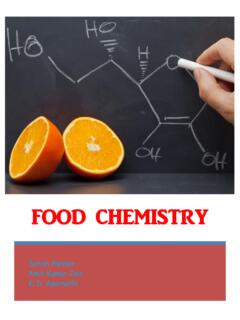Transcription of Food Laws and Regulation - EOLSS
1 UNESCO EOLSSSAMPLE CHAPTERSFOOD QUALITY AND STANDARDS Vol. I - food laws and Regulation - Radomir L sztity Encyclopedia of Life Support Systems ( EOLSS ) food laws AND Regulation Radomir L sztity Department of Biochemistry & Technology, Budapest University of Technology & Economics,Hungary Keywords: food law, food Regulation , food additives, food act, food standards, adulteration, chemical/microbial/environmental contamination, code of hygienic practice, residue limits, health risks, nonobservable effect level (NOEL), food labeling, harmonization Contents 1.
2 Introduction 2. The Structure of food Law 3. food Regulation What Should be Regulated? food Standards laws and regulations to Prevent Gross Adulteration and Contamination Microbial Contamination, Hygienic Practice Chemical and Environmental Contamination food Additives Labeling 4. Harmonization of food laws and regulations at the International Level Glossary Bibliography Biographical Sketch Summary Every nation needs an effective food legislation and food control service to promote a safe, honestly presented food supply, and to protect consumers from contaminated, adulterated, and spoiled foods.
3 Generally the food law is divided into two parts: a basic food act and regulations . The Act itself sets out broad principles, while regulations contain detailed provisions. The principles or general provisions to be included in food law are primarily: basic purposes and scope, definitions of basic concepts, inspection, enforcement, biological and chemical contaminants, packaging and labeling, and procedures for the preparation and amendment of the regulations for implementation of the law. food law is based on scientific studies.
4 Harmonization of food Law on the international level is a worldwide trend from the late twentieth century. 1. Introduction Every country needs laws to encourage the production of safe and wholesome foods, and to prohibit the sale of foods that are unsafe or fraudulent. The growing population has placed demands on agriculture for increased production. However, the increase of agricultural production is connected with the wider use of chemicals. Protection of food during transport and storage may require the use of chemicals, too. UNESCO EOLSSSAMPLE CHAPTERSFOOD QUALITY AND STANDARDS Vol.
5 I - food laws and Regulation - Radomir L sztity Encyclopedia of Life Support Systems ( EOLSS ) The centralized processing of foods in large quantities increases the chances of contamination. There is an increasing demand for convenience foods, foods ready-to-serve or which can be quickly prepared for serving. Because food additives are commonly used in these foods, and because convenience foods are especially susceptible to contamination, strict hygienic and safety precautions are needed. Expansion of the food trade, both within countries and with other nations, needs Regulation not only at the national but also at the international level.
6 In past centuries, international trading in food took place with little, if any, government intervention, and it was accepted that the food producers set their own standards and determined the quality of food products offered to consumers. Many businesses were responsible and took great care to protect the health of consumers. However, some dishonest traders misused the unregulated markets to sell adulterated food . Such abuses led to government involvement and over time to the enactment of food laws and regulations .
7 These laws and regulations , together with food control organizations, ensure the safety of domestically produced, imported, and exported food products (see System of food Quality Standards). In the framework of this chapter, the principal requirements of food law and regulations will be treated. 2. The Structure of food Law Generally, food Law may be divided in two parts: (1) a basic food act, and (2) regulations . The Act itself sets out broad principles, while regulations contain detailed provisions governing the different categories of products coming under the jurisdiction of each set of regulations .
8 Sometimes food standards, hygienic provisions, lists of food additives, chemical tolerances, and so on are included in basic food control law. For effective administration of and enlightened compliance with the basic food law, detailed provisions are needed. In governments where there is a division between the responsibilities of the legislative and executive branches, the legislative branch enacts the basic law, while detailed regulations are elaborated and promulgated by the executive agency or agencies responsible for administering the law.
9 Inclusion in the law of detailed specifications about food processing, food standards, hygienic practices, packaging and labeling, food additives, and pesticides may make for difficulties. Prompt revisions of regulations may become necessary because of new scientific knowledge, changes in food processing technology, or emergencies requiring quick action to protect public health. Such revisions can be made much more expeditiously by executive agencies than by legislative bodies. In some countries food standards are part of the regulations ; in other countries they are separate enactments.
10 Regardless of whether they are included in regulations or are separate, they become part of the enforcement structure, and are intended to implement basic food law. UNESCO EOLSSSAMPLE CHAPTERSFOOD QUALITY AND STANDARDS Vol. I - food laws and Regulation - Radomir L sztity Encyclopedia of Life Support Systems ( EOLSS ) Concerning the principles or general provisions to be included in basic food law, the following points should be stressed: basic purposes and scope of the law definitions of basic concepts competence for implementation of the law inspection and analytical procedures and facilities enforcement, procedures for enforcement, penalties regulations for additives, pesticides, contaminants packaging and labeling procedures for the preparation and amendment of the regulations for implementation of the law The basic food law is intended to assure consumers that foods are pure and wholesome, safe to eat, and produced under sanitary conditions.














